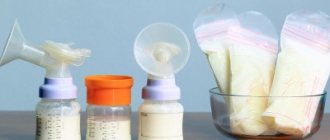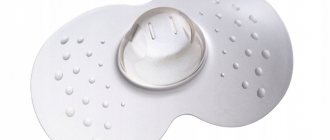Excessive production of breast milk causes a lot of inconvenience to a nursing mother. She is forced to regularly resort to additional pumping to prevent stagnation and further troubles with her breasts.
The babies of such mothers also have a difficult time: it can be difficult for them to suckle due to an overly active flow of milk, feeding becomes nervous and fussy. These difficulties are accompanied by less significant but unnerving moments - unpleasantly overfilled breast pads, excessive milk leakage, more dirty diapers and nappies. But if a mother wants to reduce her breast milk production, she first needs to understand whether she really has too much milk.
When is it necessary to reduce lactation?
The need to slow down the rate of milk production usually occurs in case of hyperlactation. The main symptom of this condition is very rapid breast fullness. For example, the baby ate only half an hour ago, and has not yet expressed readiness to suck again.
And my mother’s breasts are already engorged and are experiencing noticeable discomfort and even pain. If under such conditions a woman does not express at least a little secretion, the risk of swelling, blockage of the ducts, lactostasis and subsequent mastitis (inflammation) increases. Therefore, women often find themselves in a vicious circle: they cannot help but relieve their condition by pumping, and frequent emptying of the breasts leads to even greater milk production.
Excess milk often accompanies the first three months of a baby's life. The mother's body adapts to the child's needs gradually, and by three months the secretion production stabilizes. That is, the breast produces exactly as much nutrition as the baby sucks. Supply equals demand. And at first there is an abundance of milk, because, figuratively speaking, the woman’s body does not understand how many children need to be fed.
The problem of excess lactation
Most babies whose mothers experience hyperlactation gain weight too quickly. Their natural desire is to suck frequently, and not just for the sake of getting food. But with each attachment, the child receives another portion of nutrition. Therefore, increases can be significantly higher than normal.
The opposite situation also happens: the baby’s weight increases more slowly than is acceptable for an infant. The reason for this may be a lack of milk supply, since the baby finds it difficult to cope with its strong flow. He may nurse frequently but not actually get enough milk. Regurgitation due to swallowing air during feeding can also interfere with weight gain.
Signs
When a mother has a lot of milk, other features may appear in her well-being and the baby’s behavior during breastfeeding. They may or may not accompany this condition, so they cannot be considered reliable evidence of excess milk production. Other possible signs of hyperlactation include the following.
- Constant and abundant leakage of milk. When the baby suckles on one breast, milk actively flows out from the other side. This situation can also happen between feedings. Sometimes mothers have to change several diapers on their chest while the baby is sucking. And during the day, throw away more than one bra pad. However, copious leakage of secretions also occurs in women without hyperlactation.
- Restless behavior of the child at the breast. Babies from very milky mothers often fuss, get nervous and cry during feedings. They take and release the breast, hiccup, spit up and cannot cope with the strong flow of fluid.
- The milk flows out in an active stream. This is a completely normal situation to start feeding. But it happens that the force of the flow does not weaken even after a few minutes.
- Short but frequent applications. Since the abundance of milk does not allow the baby to suckle comfortably, he may ask for the breast too often. In this case, the duration of application may not exceed several minutes. Although, normally, healthy children are able to get enough after five to seven minutes of effective sucking.
- Excessive gas and strange stools. Babies from mothers with hyperlactation often have abnormal stools: foamy, watery, greenish in color.
- Repeated blockages of the ducts, lactostasis and mastitis. Excess secretion and its untimely removal often lead to problems with the mammary gland. However, these consequences also have other reasons (errors in attachment, infectious disease, rare feedings).
Causes
Hyperlactation can be caused by hormonal characteristics of the female body. It can also be encountered by mothers who carefully follow the advice to express “to the last drop” after each feeding. Excess milk also appears when breasts are changed frequently during one feeding. That is, the baby is transferred to the other side before he has completely emptied the first. This happens even if you follow the recommendations to keep the baby at each breast for a certain number of minutes so that he is sure to receive milk from both glands at the same time.
How does it affect the child?
Abundant milk production, it would seem, is not a problem at all. After all, many mothers are struggling to increase its volume. Meanwhile, hyperlactation can seriously worry the baby. Frequent and short sucking with constant breast changes leads to the fact that the baby does not empty the gland completely.
He receives mainly “foremilk”, rich in lactose (milk sugar). It has a very low percentage of fat, so it is less nutritious. Normally, the baby drinks it at the very beginning of feeding. With prolonged sucking, particles of fat are added to it. And the longer the feeding, the more high-calorie milk the baby sucks out.
If the baby is breastfed often, but not for long, and at the same time moves from one breast to the other during one feeding, he gets the “fore milk”. The intestines are filled with an excess amount of lactose with a reduced fat content. This disrupts normal digestion processes and leads to rumbling in the stomach, excessive gas accumulation, and foamy and green stools. Naturally, these problems bother the baby and spoil his mood.
What's the result? Frequent attachments, crying and nervousness of babies at the breast make mothers think that they have little milk. Or it is not nutritious enough to satisfy the child's needs. Although, in reality, there is more nutrition than is needed. Thus, unreasonable supplementary feeding with formula may appear in the baby’s life.
Video on the topic Mama Lara about excess breast milk
Why is so much milk produced: causes of hyperlactation
Three to five days after the baby is born, young mothers feel a rush of milk. This happens because the body does not yet know how much nutrient fluid is enough to saturate the baby. Usually, after six to ten weeks, lactation is established and nutrition for a son or daughter occurs according to the principle of supply and demand. This resembles the following scheme: the child ate a certain amount of liquid during one feeding, which means that after a few hours, by the next meal, the same volume of milk is formed in the ducts.
After eight to twelve weeks, the young mother gets used to the new pace of life. The child also adapts to the environment, develops his own schedule of feeding, sleeping and active pastime. Therefore, the body adapts to the baby’s needs and controls the formation of the amount of mother’s milk.
However, some breastfeeding women are faced with a situation where the mammary glands produce an excessive amount of valuable fluid - hyperlactation. Some mothers think that in such a situation they should be happy. But this is a misconception: hyperlactation negatively affects the condition of the mother and the health of the baby. A woman often develops congestion and lactostasis, and the baby suffers from indigestion, frequent regurgitation and pain in the abdominal area. Doctors distinguish two types of hyperlactation: primary and secondary. The difference between them lies in the reasons that provoked excessive milk production.
Table: causes of primary and secondary hyperlactation
| Hyperlactation | Characteristics of hyperlactation | Causes of excess formation of valuable fluid for feeding a baby |
| Primary | Occurs immediately after the birth of a child. The production of breast milk in large quantities begins due to hormonal imbalance in the body of a nursing mother. Gynecologists explain: for forty weeks, all organs and systems directed their work towards bearing the fetus, and after the birth of the child, priorities changed. Now the body is configured to feed the newborn. In some cases, a malfunction occurs and the release of hormones into the blood increases or decreases. These factors provoke primary hyperlactation |
|
| Secondary | The development of hyperlactation in this case is provoked by errors in organizing the breastfeeding process on the part of the youngest mother. Many breastfeeding women ignore the recommendations of doctors or breastfeeding consultants and listen to the advice of the older generation, although some of them are harmful to the development of lactation or the health of the mother |
|
In some cases, young mothers themselves are to blame for the occurrence of hyperlactation by improperly organizing the breastfeeding process
Influencing factors
Modern doctors have proven that the production of the hormones prolactin and oxytocin largely depends on the psycho-emotional and physical state of the young mother, as well as on the proper organization of the process of feeding the baby:
- excellent health. After the birth of a child, a woman has practically no free time, because the baby is still helpless and needs round-the-clock care and attention. Many mothers sleep several hours a day, get very tired, and this affects their physical condition. The body simply does not have enough strength to produce milk, so the husband and other relatives must help the woman so that she has time to rest;
- emotional peace. If the mother is charged with positive emotions and enjoys communicating with the newborn, the hormone oxytocin is produced in sufficient quantities, and this promotes the formation of breast milk in the ducts;
- Regular attachment to the baby's nipple. Today, gynecologists insist that after birth the child takes the breast as early as possible. Then it is necessary to feed the baby often, especially not to skip night feedings (at this time prolactin enters the blood in larger quantities). After two to three months, the baby will develop a feeding schedule and the mother will already know the approximate time when the baby will get hungry;
- balanced diet. The menu of a nursing woman should be varied and include foods rich in vitamins and nutrients that are necessary for the full development of the baby. If nutritional elements enter the mother's body with food, this helps maintain the woman's health, so there is enough strength for the formation of breast milk.
According to the recommendations of breastfeeding consultants, if you properly organize the process of feeding a child, this will have a positive effect on lactation and the young mother may not face the problem of excess milk production. However, in the case of primary hyperlactation, when the cause is problems with the hormonal system, you cannot do without the help of a doctor.
Doctors do not recommend self-medication. If a nursing mother is concerned about the formation of nutrient fluid in large quantities, you need to make an appointment with a doctor. The gynecologist will definitely ask about the baby’s feeding regimen, the woman’s diet, as well as her mood and health. If necessary, he will prescribe tests for hormone levels. Based on the results, the doctor will determine the cause of the problem and develop a treatment regimen.
Bad advice and myths
In attempts to “tame” lactation, nursing mothers often make the same type of mistakes. Because of this, they not only cannot cope with excess milk, but also aggravate the situation.
What a mother with hyperlactation should not do:
- constantly use a breast pump;
- express after each feeding;
- try to express your breasts “to the bottom”;
- often shift the baby from one side to the other during one feeding;
- change breasts every feeding;
- ignore the feeling of painful fullness in the chest;
- crush, crush, traumatically strain the gland;
- uncontrollably take herbs and medications to suppress lactation;
- tightening your breasts and wearing tight underwear.
Decreased milk production when complementary foods are introduced
Nursing mothers with excessive milk secretion make a lot of efforts to establish lactation in a comfortable manner. Many of them then strive to feed their babies for as long as possible. Therefore, the slightest changes in breastfeeding rhythms cause concern and anxiety. For example, there is an opinion that when you introduce complementary foods, the amount of milk decreases. In fact, complementary feeding products complement, rather than replace, mother's milk.
Breastfeeding remains approximately the same daily amount (10-12 times), but they are distributed differently throughout the day. An older baby breastfeeds mainly around dreams and at night. During the day he eats regular food. Therefore, if you maintain a sufficient number of latch, milk production will not change even during this period.
But when a child is weaned, milk secretion actually decreases. With the physiological completion of lactation, this occurs smoothly and painlessly. But here, too, the need to periodically express is not excluded. When the number of feedings is reduced, the breast does not immediately adjust to the new regime. From time to time she needs help - to pump up the discomfort until she gets relief. This applies not only to mothers with excess milk production, but also to mothers with normal secretion production.
Related video Nina Zaichenko talks about the problem of hyperlactation
Hyperlactation leaves mothers wondering how to reduce their breast milk supply. There are simple and effective ways to do this that you just need to try in practice. There is another alternative: not to fight the abundant “rivers of milk”, but to use them for the benefit of other children. Some mothers choose to become breast milk donors. They donate the surplus to a special milk bank. And from there he is taken by women who, for various reasons, are not able to feed their children themselves. So addressing hyperlactation can be a wonderful way to help other babies stay healthy.
How to reduce lactation
Depending on the causes of hyperlactation, the doctor will give a list of recommendations on what a young mother needs to do to improve milk production. In each individual case, the advice and prescriptions are different, because each family has a different situation, its own feeding regime for the child and other features in the life of young parents.
Today, most drugs can be bought without a doctor's prescription. Therefore, women consult among themselves, for example, one mother was prescribed hormonal pills, which turned out to be effective, so the other goes to the pharmacy and buys the same drug. However, it is worth remembering that medications and herbs can have the opposite effect, worsening the situation.
Methods for reducing lactation do not always necessarily involve taking medications. Sometimes it is enough to establish a feeding regime and the problem will go away after a while. Therefore, in each case, ways to combat excess milk production depend on the cause of the problem.
Only a doctor can give recommendations on how to combat hyperlactation
Natural ways
First of all, a woman is recommended to establish a feeding regimen and properly attach the baby to the breast. Lactation consultants strongly recommend adhering to the following rules while breastfeeding your baby:
- Divide feeding into blocks. This technique is often recommended by experts to cope with hyperlactation. Its essence is as follows: the young mother decides for herself how long the period of time (block) will last, for example, two, three or four hours. As soon as the baby wants to eat, the woman places him on one breast during this period of time. With the onset of the second block, it is necessary to change the breast and feed the child only with it. Alternate the mammary glands in this way until the milk production process is normalized;
According to reviews, within seven days, many nursing mothers successfully overcome hyperlactation.
- During one meal, offer the baby only one mammary gland. This is necessary so that the baby produces not only fore milk, but also hind milk, which is more nutritious. Gradually, the body will understand how much liquid the child needs to be completely saturated and will not produce milk in excess;
The main rule of this point is not to express your breasts after the baby has eaten.
- Don't give up using a pacifier. Up to six months, children have a very developed sucking reflex. Therefore, they often use the mother’s breast not only to obtain nutritional fluid, but also to calm them down. In order not to stimulate the nipples unnecessarily, it is worth offering the baby a pacifier;
- no need to massage the mammary glands. If a young mother does not have lumps or stagnation of milk, it is not recommended to massage her breasts. These actions lead to an increase in the production of oxytocin, as a result of which milk actively flows to the ducts. It is enough to carry out a preventive massage for no more than three minutes in order to prevent lactostasis;
The same applies to hydromassage while swimming. There is no need to direct warm streams of water to the area of the mammary glands for a long time, this will only provoke an influx of fluid.
- You should completely avoid emptying your breasts using a breast pump or manually. If a woman does not experience pain, there is no need to express milk. The procedure is allowed only if the breasts are engorged and sore. In this situation, you can slightly empty the mammary gland until the condition improves.
Folk remedies
The use of traditional methods can also help cope with excess milk flow during lactation:
- drink decoctions and infusions of medicinal herbs, for example, sage, bearberry. It is these plants that doctors recommend using to treat hyperlactation. Experts also recommend drinks with a diuretic effect: lingonberry and cranberry fruit drinks;
It is worth paying attention that some herbs and berries can negatively affect the baby’s health. Therefore, before you start using decoctions, you should definitely consult a doctor.
- use cold compresses. This method does not in any way affect the process of producing nutrient fluid, but it will help relieve pain if the breasts are heavily filled with milk, as well as reduce the flow of fluid, because cold affects blood circulation: it slows down;
- compresses with cabbage leaves. This method is familiar to more than one generation of women who breastfed. Cabbage leaf juice helps not only to alleviate the condition, but also to cope with inflammation in the tissues;
Doctors note: compresses with camphor oil should not be used. This remedy is most often used when a woman wants to complete lactation. However, camphor passes into breast milk and causes cramps, headaches and vomiting in the baby. In some cases, the baby may fall into a coma.
Sage infusion is often used to reduce milk production
Use of medications
The drug market offers drugs to stop lactation. Most often it contains hormonal components that suppress the production of prolactin in the body of a young mother. However, these drugs are prohibited from being used without a doctor's prescription. The gynecologist prescribes medications in cases where hyperlactation is caused by hormonal imbalance and the functioning of the system can only be adjusted with the help of medications.
Drugs to stop lactation have a long list of side effects, so self-medication in this case is unacceptable.
It should also be noted that when taking many medications, it is forbidden to breastfeed the baby so as not to harm the baby’s health.
Menu for a nursing mother
Doctors disagree on whether many foods affect milk production. However, when fighting hyperlactation, it is recommended to minimize the consumption of first courses, not to drink hot teas with milk and herbal teas that help stimulate milk production.
There is no need to limit yourself in fluid intake. You just need to drink drinks at room temperature, because... Hot drinking provokes a rush of nutrient fluid to the ducts.
In what mode should you feed your baby to reduce lactation?
Experts recommend organizing the feeding regimen in a way that is convenient for both mother and baby. Some women are of the opinion that the baby should be fed on a schedule, while others are absolutely sure that the baby should be put to the breast only on demand. In each specific case, young parents choose the method that is convenient for their family.
Dr. Komarovsky recommends teaching your child a routine from birth so that in the future mom and dad can plan their free time, and the baby knows exactly when he needs to eat, sleep or play.
During hyperlactation, breastfeeding consultants advise adhering to the following basic points:
- if the breast is too full, you need to express the liquid a little and only then apply the baby to the nipple;
- It is better to feed the baby in a supine or reclining position. In this case, the baby lies on the mother's stomach. In this position, the nutrient fluid will not flow in a rapid stream, and it will be more convenient for the baby to suck;
- It is convenient to put the baby to the breast when the mother is lying on her side. If there is too much milk, it will simply flow out of the baby’s mouth;
It is worth laying down a quick-absorbing diaper so as not to wet the bed.
This feeding position is considered the most comfortable for hyperlactation.
Feedback from nursing mothers: how to cope with excessive milk production
A few days after the milk began to arrive, hyperlactation began. I just couldn't handle my breasts. The baby has eaten - I express and so on in a circle. I couldn’t express myself - my mother helped. My temperature rose, I didn’t eat or drink anything (because I drink and everything goes to my chest), my joints hurt and delirium began. I just lay there, I couldn’t even pick up the baby. They tried to “treat” me, but only drug intervention saved me.
Musyavka
https://www.komarovskiy.net/forum/viewtopic.php?t=11597
It was like this with the first one... no way without a breast pump. I don’t know how much excess I poured out, I poured out about a liter a day... I even wanted to wrap it up... I solved the problem by expressing not completely, until I felt relief... I suffered for almost a month... but it became easier, I need to measure the pace in the elbow bend, because... fiery breasts when milk comes in... this is how I solved my problem.
Svetlanka
https://www.baby.ru/community/view/3335924/forum/post/80295958/
In the first days, my chest also swelled and my temperature rose. But 3-5 days and everything returned to normal. I pumped until I felt relief and drank less. That's all.
Elena76
https://www.komarovskiy.net/forum/viewtopic.php?f=15&t=11597&sid=0fcaef7aaaefade77332d1195b2d7b77&start=15
For the first three months I had a lot of milk, probably 2-3 liters a day. All I did was pump, my hands were very tired. My daughter often choked and had to pump even before feeding. I was afraid that it would be like this all the time, but then everything got better, the milk became less.
Natalie
https://www.komarovskiy.net/forum/viewtopic.php?f=15&t=11597&start=30
I can advise, I myself went through hyperlactation, the milk was like yours, tea with mint will help you, it extinguishes a little, just don’t overdo it, don’t express too much even if your breasts remain full for a couple of days, maximum a week of torment and the milk will be exactly as much as the baby needs and stupid there will be no hot flashes, the correct flow of milk occurs at the moment the baby sucks the breast!!!
malbishka
https://www.babyplan.ru/questions/102798-giperlaktatsiya/











